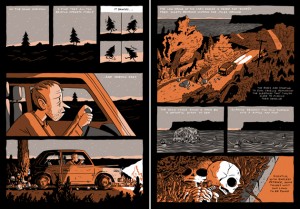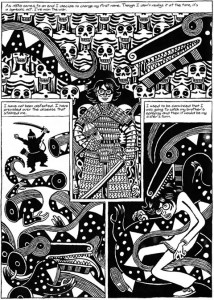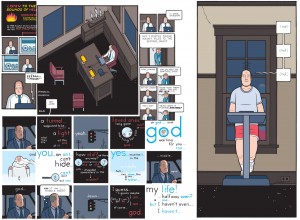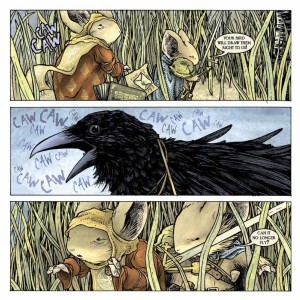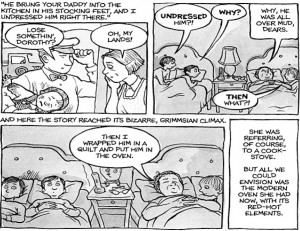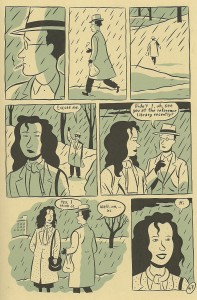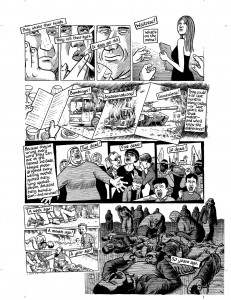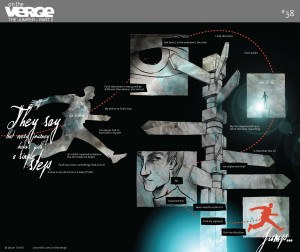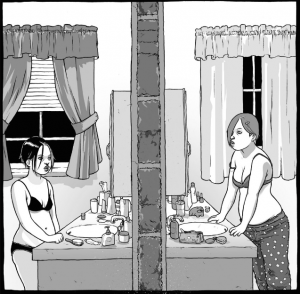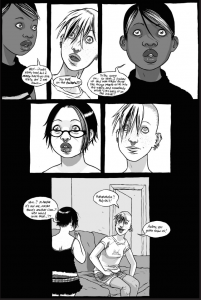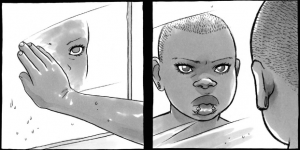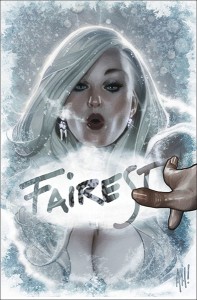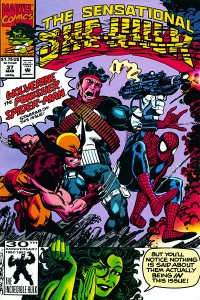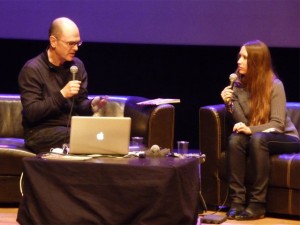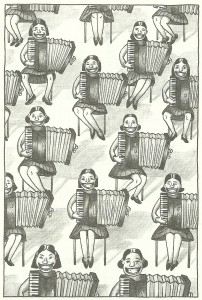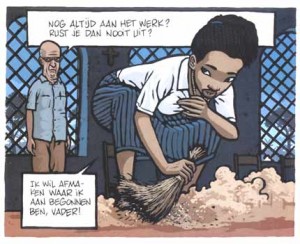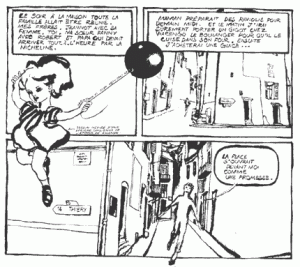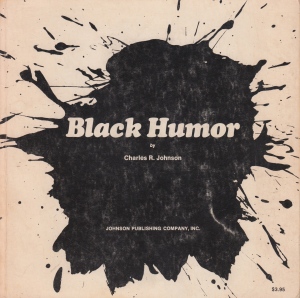
The cover of Johnson’s 1970 collection.
Note: This essay on Charles Johnson’s Black Humor is a cross-post from my blog. It’s also a preview of a roundtable on Thierry Groensteen’s Comics and Narration that will begin here at Pencil, Panel, Page in a few weeks.
Early in Chapter Two of Comics and Narration, theorist Thierry Groensteen extends some of the questions he first posed in The System of Comics, also available in an English translation from the UP of Mississippi. “Can an isolated image narrate?” he asks. “Can it, on its own, tell a story?” (Groensteen 21). I’d like to consider this question in relation to “It’s life as I see it” from Charles Johnson’s 1970 collection Black Humor. Groensteen borrows some ideas from film theory in order to explore the narrative potential of single, static images: “Some film theorists,” he points out,
most notably André Guadreault, have asserted that an intrinsic narrativity is associated with movement, because it implies a transformation of the elements represented. Obviously, the same cannot be said of the still image. Given that its narrative potential is not intrinsic, it can only arise, where it does arise, out of certain internal relationships between objects, motifs, and characters represented. (Groensteen 21-22; English translation by Ann Miller)
With Groensteen in mind, I’d like to consider the “internal relationships” of the “objects, motifs, and characters” in this single-page cartoon, in which an African American artist explains his work to an older, white visitor. As I took notes on Johnson’s work, I thought again about Qiana’s “What is an African American Comic?” from earlier this year on Pencil, Panel, Page. I am thinking about how theories from African American literary theory and philosophy might inform our readings of comic strips, comic books, and graphic novels. But I also have larger questions in mind—what secrets will Johnson’s cartoon reveal when also read as part of the tradition of American literary discourse? What affinities might we discover, for example, if we juxtapose Johnson’s “It’s life as I see it” with Phillis Wheatley’s poem about the work of artist Scipio Moorhead, for example?
Of course, by writing about Johnson’s cartoon, I’m cheating a little. Is this really a single-page comic? It might be read as a work containing at least three panels—the image itself, as well as the artist’s two paintings: the one hanging on the wall and the other work-in-progress on his easel. So I should revise what I asked earlier: how do we read a single panel or page like this one that includes other, smaller images embedded within a larger frame? Here is “It’s life as I see it” from Black Humor:
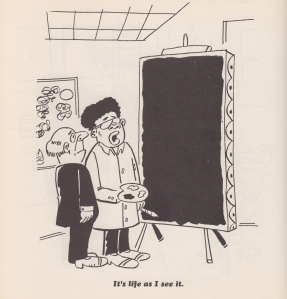
Johnson, as Tim Kreider points out in his 2010 TCJ essay on the artist, is best known as one of the most influential and visionary American novelists of the last thirty years. Middle Passage, which won the National Book Award in 1990, is now a perennial text in 20th century American and African American literature courses—I’ll be teaching it again in one of my classes this fall—and Dreamer, his 1998 novel about Dr. Martin Luther King’s experiences in Chicago in 1966, is, like Edward P. Jones’s The Known World, one of the most complex and evocative historical novels of the last two decades.
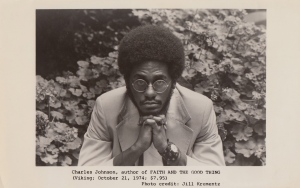
Jill Krementz’s 1974 publicity photo of Johnson for the
writer’s first published novel, Faith and the Good Thing (Viking).
Writing about Johnson’s early work as a cartoonist, Kreider writes, is like trying “to give a magnanimous little career boost to a struggling unknown cartoonist named Wolfe or Fellini.” But as his introduction to Fredrik Strömberg’s 2003 book Black Images in the Comics makes clear, Charles Johnson has a deep affection for comic books and comic art. In the conclusion to his essay, Johnson includes a discussion of the kinds of comics he would like to read:
I long—as an American, a cartoonist, and a writer—for a day when my countrymen will accept and broadly support stories about black characters that are complex, original (not sepia clones of white characters like “Friday Foster” or “Powerman”), risk-taking, free of stereotypes, and not about race or victimization. Stories in which a character who just happens to be black is the emblematic, archetypal figure in which we—all of us—invest our dreams, imaginings and sense of adventure about the vast possibilities for what humans can be and do—just as we have done, or been culturally indoctrinated to do, with white characters ranging from Blondie to Charlie Brown, from Superman to Dilbert, from Popeye to Beetle Bailey. (Johnson 17)
Johnson’s argument here raises interesting questions about the page from his 1970 book. As readers, with whom do we identify? With the artist who shows his work or with the man who stares at the black canvas? Do we immediately identify with one or the other based on our race? What role does gender play? Do we identify with neither but find ourselves observing what Groensteen calls the “internal relationships” between these two men and the objects that surround them? I think an answer to these questions might lie in the juxtaposition of the artist’s two canvases. One is abstract. The other, the one on the easel, is the more realistic of the two, although it is less figurative than the one hanging on the wall. “It’s life as I see it,” the artist explains.
I find myself working in collaboration with Johnson as I read this page. First of all, where are we? This appears to be the artist’s studio. Is this a studio visit by a curator? By a patron? Why is the middle-aged, balding man so startled? Was he expecting something else? The artist’s other work appears more conventional—a variation on Pollock’s Abstract Expressionism. Now the artist is a minimalist. Then again, I don’t know if the painting on the easel is finished. Maybe it’s still in progress. The painter, after all, is holding a palette and brush and he is wearing a white smock.
The questions raised by Johnson’s cartoon are also present in Charles W. Mills’ “Non-Cartesian Sums: Philosophy and the African-American Experience,” the essay that opens his 1998 book Blackness Visible. In the essay, Mills describes the obstacles he faced as he designed a course on African-American philosophy. First, for example, he “had to work out what African-American philosophy really was, how it related to mainstream (Western? European/Euro-American? Dead White Guys’?) philosophy—where it challenged and contradicted it, where it supplemented it, and where it was in a theoretical space of its own” (Mills 1). Mills turned to Ralph Ellison’s Invisible Man as a guiding text. As he reflected on the experiences of Ellison’s narrator, Mills began to formulate a conceptual basis for his course:
African-American philosophy is thus inherently, definitionally oppositional, the philosophy produced by property that does not remain silent but insists on speaking and contesting its status. So it will be a sum that is metaphysical not in the Cartesian sense but in the sense of challenging social ontology; not the consequent of a proof but the beginning of an affirmation of one’s self-worth, one’s reality as a person, and one’s militant insistence that others recognize it also. (Mills 9)
In Johnson’s cartoon, the artist asserts his subjectivity. The painting, like the cartoon’s caption, is a simple statement of fact: life as he sees it. The painting breaks the silence that Mills refers to in this passage. The humor in this cartoon—the disconnect between what the man in the suit expects to see and what he finds on on the easel before him—is part of Johnson’s narrative, I think: a cartoon is a work of popular art that challenges our notions of fine art, just as the painter’s canvas challenges the observer’s narcissistic complacency.
This new painting, then, is like a course in African American philosophy, one that makes certain demands on the curriculum as it articulates “a (partially) internal critique of the dominant culture by those who accept many of the culture’s principles but are excluded by them. In large measure,” Mills continues, “this critique has involved telling white people things that they do not know and do not want to know, the main one being that this alternative (nonideal) universe is the actual one and that the local reality in which whites are at home is only a nonrepresentative part of the larger whole” (Mills 5-6). The subject of Johnson’s narrative is the dissonance between what the observer believes and what the artist knows to be true.
As I look at the cartoon, I also wonder if I might trace its origin to one of the earliest collaborations of words and pictures in American literature, that of Phillis Wheatley and artist Scipio Moorhead.
Wheatley’s poem about Moorhead’s work appears in her 1773 book Poems on Various Subjects, a text that includes an engraving based on Moorhead’s portrait of the poet (you can read more about Wheatley and Moorhead here and here). “To S.M. A Young Painter, On Seeing His Works” opens with a question as the speaker studies one of Moorhead’s paintings:
To show the lab’ring bosom’s deep intent,
And thought in living characters to paint,
When first they pencil did those beauties give,
And breathing figures learnt from thee to live,
How did those prospects give my soul delight,
A new creation rushing on my sight?
An important difference between Johnson’s cartoon painter and Moorhead, however, is that Moorhead’s work, with the exception of his portrait of Wheatley, has not survived. As we read this poem, we must imagine his drawing, the evidence of his “lab’ring bosom’s deep intent” which has brought life to these “characters” and “beauties.” After a detailed description of her response to Moorhead’s work, Wheatly concludes the poem with a plea:
Cease, gentle muse! the solemn gloom of night
Now seals the fair creation from my sight.
But while night and shadow might obscure Moorehead’s drawing, it remains vivid and startling in her memory. When I first saw Johnson’s cartoon, I immediately thought of Wheatley’s poem (and of Adrielle’s early Pencil, Panel, Page essay on comic scholarship and ekphrasis). At the end of the poem, as night falls, the speaker can no longer see Moorhead’s painting, so she does the next best thing: she writes it from memory and, therefore, gives her friend the lasting fame that Shakespeare’s speaker promises to his subject in the Sonnets. The poem, like Johnson’s panel, is filled with light and meaning that some observers, like the old man in the suit, might fail or refuse to see.
Johnson’s “It’s life as I see it” is an interesting test case for Groensteen’s theories, not only because it is a single image that narrates, but also because it is part of a collection of other cartoons. At the end of Chapter Two of Comics and Narration, Groensteen discusses Frans Masereel’s woodcut novels and Martin Vaughn-James’s The Cage (see Groensteen 35). These examples, of course, are not collections of single-page cartoons, but Groensteen’s suggestion on how we read and respond to these texts might shed light on how we read a collections like Black Humor. “In works of this type,” Groensteen explains, in which “there are never more than two images visible to the reader at any one time, split across two pages,” the reader’s imagination and memory play a crucial role: “The dialogue among the images depends on the persistence of the memory of the pages already turned” (Groensteen 35).
The next page in Johnson’s book, for example, shares affinities with “It’s life as I see it.” An older white gentleman and his wife listen to a Beethoven recital. The pianist, his hands perched dramatically over the keyboard, is about to begin. A gray-haired old man in the audience whispers, “Psst, he’s a mulatto…pass it on.”
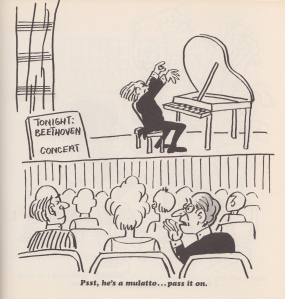
The cartoon that appears on the page opposite
“It’s life as I see it” in Johnson’s Black Humor.
By placing these two cartoons together, Johnson, according to Greonsteen’s theory, is also challenging the reader—how does our reading of one page shape our understanding and recollection of the images on the pages that preceded it? Both of these cartoons invite us to consider two African American artists–a painter and a musician–and the white audience members who observe them.
But how do you read “It’s life as I see it”? Is it a single-panel cartoon , and, if so, what can it tell us about “the persistence of memory,” as Groensteen describes it?
References
Groensteen, Thierry. Comics and Narration. Trans. Ann Miller. Jackson: UP of Mississippi, 2013. Print.
Johnson, Charles R. Black Humor. Chicago: Johnson Publishing Company, Inc., 1970. Print.
Johnson, Charles. “Foreword” in Fredrik Strömberg, Black Images in the Comics: A Visual History. Seattle: Fantagraphics, 2003. 5-18. Print.
Kreider, Tim. “Brighter in Hindsight: Black Humor by Charles R. Johnson.” The Comics Journal. January 18, 2010. 9:00 am. Web.
Mills, Charles W. Blackness Visible: Essays on Philosophy and Race. Ithaca: Cornell University Press, 1998. Print.
Wheatley, Phillis. “To S.M. A Young African Painter, On Seeing His Works.” Poetry Foundation. Web.
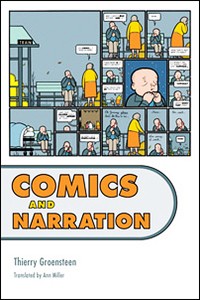 In Comics and Narration Thierry Groensteen introduces a four-part taxonomy by which we (or at least he) categorizes comics in terms of the nature and structure of panel layout. The taxonomy consists of different ways in which the payout of the panels might be more or less regular:
In Comics and Narration Thierry Groensteen introduces a four-part taxonomy by which we (or at least he) categorizes comics in terms of the nature and structure of panel layout. The taxonomy consists of different ways in which the payout of the panels might be more or less regular: The density of panels on a particular page – i.e. criterion (4) – while discussed at the same time as the first three criteria, is somewhat orthogonal to measuring the regularity of a page although variation in density from page to page obviously increases the irregularity of the comic in the relevant sense. Clearly, however, if the number of panels on a page varies from page to page, then as a matter of geometrical fact their layout must as well – thus, with regard to measuring regularity criterion (4) is redundant, subsumed under criterion (1).
The density of panels on a particular page – i.e. criterion (4) – while discussed at the same time as the first three criteria, is somewhat orthogonal to measuring the regularity of a page although variation in density from page to page obviously increases the irregularity of the comic in the relevant sense. Clearly, however, if the number of panels on a page varies from page to page, then as a matter of geometrical fact their layout must as well – thus, with regard to measuring regularity criterion (4) is redundant, subsumed under criterion (1).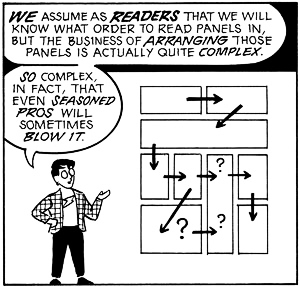 Digression: One pet peeve of mine is the tendency of scholar in the humanities – comics scholars definitely included – who propose taxonomies as if a system of categories is an intellectual end in and of itself (and as if they are following a more ‘scientific’ methodology). A taxonomy is a tool, however, not a result.
Digression: One pet peeve of mine is the tendency of scholar in the humanities – comics scholars definitely included – who propose taxonomies as if a system of categories is an intellectual end in and of itself (and as if they are following a more ‘scientific’ methodology). A taxonomy is a tool, however, not a result.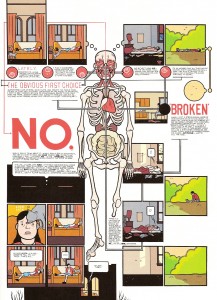 Groensteen seems to think the answer to the first question is affirmative, but I just can’t see how this could be the case. As many scholars have argued (and see the predecessor to this post by Adrielle for some evidence) panel layout can be carefully attuned to the type of story being told and the way in which the teller is telling it, resulting in narrative effects that are both theoretically interesting and likely unachievable by other, more ‘traditional’ means. Chris Ware’s work, for example, would be far less compelling had it been produced in a regular 3×3 grid (interestingly, Ware somehow gets a pass from Groensteen, despite his vast deviations from panel regularity in Groensteen’s sense.)
Groensteen seems to think the answer to the first question is affirmative, but I just can’t see how this could be the case. As many scholars have argued (and see the predecessor to this post by Adrielle for some evidence) panel layout can be carefully attuned to the type of story being told and the way in which the teller is telling it, resulting in narrative effects that are both theoretically interesting and likely unachievable by other, more ‘traditional’ means. Chris Ware’s work, for example, would be far less compelling had it been produced in a regular 3×3 grid (interestingly, Ware somehow gets a pass from Groensteen, despite his vast deviations from panel regularity in Groensteen’s sense.)
